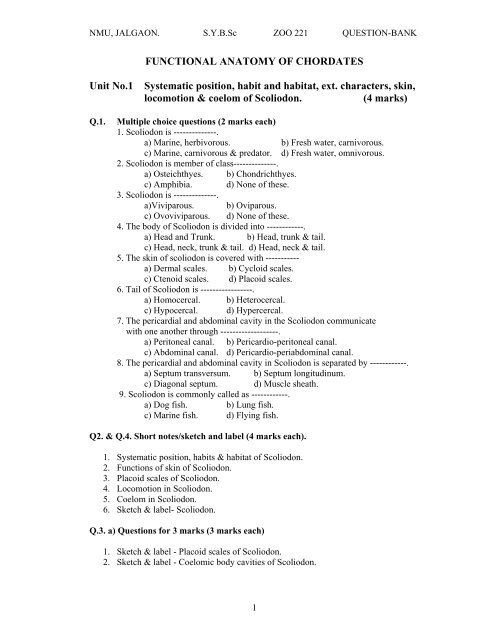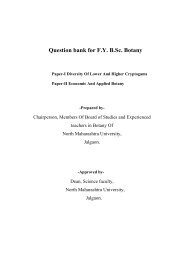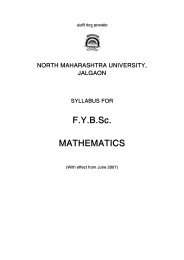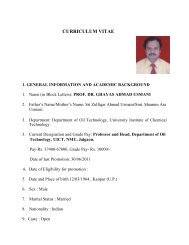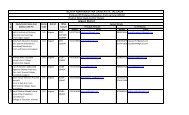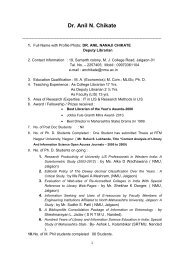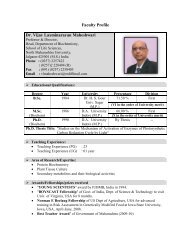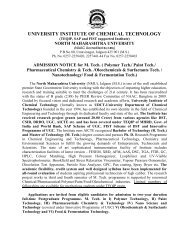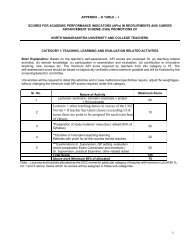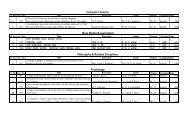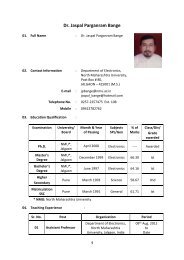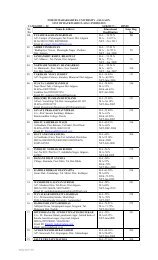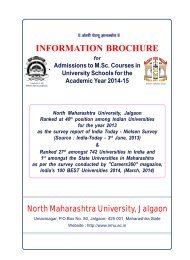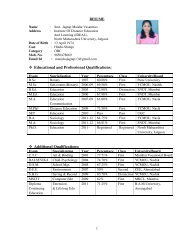S.Y.B.Sc. Zoology ( 221 ) Question Bank
S.Y.B.Sc. Zoology ( 221 ) Question Bank
S.Y.B.Sc. Zoology ( 221 ) Question Bank
You also want an ePaper? Increase the reach of your titles
YUMPU automatically turns print PDFs into web optimized ePapers that Google loves.
NMU, JALGAON. S.Y.B.<strong>Sc</strong> ZOO <strong>221</strong> QUESTION-BANK<br />
FUNCTIONAL ANATOMY OF CHORDATES<br />
Unit No.1 Systematic position, habit and habitat, ext. characters, skin,<br />
locomotion & coelom of <strong>Sc</strong>oliodon. (4 marks)<br />
Q.1. Multiple choice questions (2 marks each)<br />
1. <strong>Sc</strong>oliodon is --------------.<br />
a) Marine, herbivorous. b) Fresh water, carnivorous.<br />
c) Marine, carnivorous & predator. d) Fresh water, omnivorous.<br />
2. <strong>Sc</strong>oliodon is member of class--------------.<br />
a) Osteichthyes. b) Chondrichthyes.<br />
c) Amphibia. d) None of these.<br />
3. <strong>Sc</strong>oliodon is --------------.<br />
a)Viviparous. b) Oviparous.<br />
c) Ovoviviparous. d) None of these.<br />
4. The body of <strong>Sc</strong>oliodon is divided into ------------.<br />
a) Head and Trunk. b) Head, trunk & tail.<br />
c) Head, neck, trunk & tail. d) Head, neck & tail.<br />
5. The skin of scoliodon is covered with -----------<br />
a) Dermal scales. b) Cycloid scales.<br />
c) Ctenoid scales. d) Placoid scales.<br />
6. Tail of <strong>Sc</strong>oliodon is -----------------.<br />
a) Homocercal. b) Heterocercal.<br />
c) Hypocercal. d) Hypercercal.<br />
7. The pericardial and abdominal cavity in the <strong>Sc</strong>oliodon communicate<br />
with one another through -------------------.<br />
a) Peritoneal canal. b) Pericardio-peritoneal canal.<br />
c) Abdominal canal. d) Pericardio-periabdominal canal.<br />
8. The pericardial and abdominal cavity in <strong>Sc</strong>oliodon is separated by ------------.<br />
a) Septum transversum. b) Septum longitudinum.<br />
c) Diagonal septum. d) Muscle sheath.<br />
9. <strong>Sc</strong>oliodon is commonly called as ------------.<br />
a) Dog fish. b) Lung fish.<br />
c) Marine fish. d) Flying fish.<br />
Q2. & Q.4. Short notes/sketch and label (4 marks each).<br />
1. Systematic position, habits & habitat of <strong>Sc</strong>oliodon.<br />
2. Functions of skin of <strong>Sc</strong>oliodon.<br />
3. Placoid scales of <strong>Sc</strong>oliodon.<br />
4. Locomotion in <strong>Sc</strong>oliodon.<br />
5. Coelom in <strong>Sc</strong>oliodon.<br />
6. Sketch & label- <strong>Sc</strong>oliodon.<br />
Q.3. a) <strong>Question</strong>s for 3 marks (3 marks each)<br />
1. Sketch & label - Placoid scales of <strong>Sc</strong>oliodon.<br />
2. Sketch & label - Coelomic body cavities of <strong>Sc</strong>oliodon.<br />
1
NMU, JALGAON. S.Y.B.<strong>Sc</strong> ZOO <strong>221</strong> QUESTION-BANK<br />
Q.3.b) & Q.5. b) (2 marks each)<br />
1. Heterocercal tail.<br />
2. Gill clefts.<br />
3. Clasper.<br />
Unit No.2 Anatomy- digestive system & its physiology. (8 marks)<br />
Q.1. Multiple choice questions (2 marks each)<br />
1. The teeth in <strong>Sc</strong>oliodon are adapted for ------------.<br />
a) Holding and tearing. b) Biting.<br />
c) Chewing. d) Biting,tearing & chewing.<br />
2. Dentition in <strong>Sc</strong>oliodon is -------------<br />
a) Heterodont & diphyodont. b) Heterodont & polyphyodont.<br />
c) Homodont & diphyodont. d) Homodont & polyphyodont.<br />
3. <strong>Sc</strong>roll valve present in the intestine of <strong>Sc</strong>oliodon takes------------turns.<br />
a) one & half. b) two & half.<br />
c) Three & half. d) Five & half.<br />
4. Liver of <strong>Sc</strong>oliodon is ---------------<br />
a) Single lobed. b) Bilobed.<br />
c) Trilobed. d) Four lobed.<br />
Q2. & Q.4. Short notes/sketch and label (4 marks each).<br />
1. <strong>Sc</strong>roll valve of scoliodon.<br />
Q.3. a) <strong>Question</strong>s for 3 marks (3 marks each).<br />
1. Physiology of digestion in <strong>Sc</strong>oliodon.<br />
Q.5. a) <strong>Question</strong>s for 6 marks.<br />
1. Alimentary canal of <strong>Sc</strong>oliodon.<br />
2. Digestive glands of <strong>Sc</strong>oliodon.<br />
Q.3.b) & Q.5. b) (2 mark each).<br />
1. Define digestion.<br />
2. Bursa entiana.<br />
3. Food & feeding in <strong>Sc</strong>oloidon.<br />
Unit No.3 Respiratory system, physiology. (4 marks)<br />
Q.1. Multiple choice questions (2 marks each)<br />
1. --------------pairs of gill-slits are present in <strong>Sc</strong>oliodon.<br />
a) 3 b) 5<br />
c) 6 d) 7<br />
2. A complete gill is called -----------------.<br />
a) Hemibranch. b) Holobranch.<br />
c) Abranch. d) Lamilliform.<br />
Q2. & Q.4. Short notes/sketch and label (4 marks each).<br />
1. Mechanism of respiration in <strong>Sc</strong>oliodon.<br />
2. Sketch & label the breathing mechanism in <strong>Sc</strong>oliodon.<br />
3. Sketch & label holobranch in <strong>Sc</strong>oliodon.<br />
2
NMU, JALGAON. S.Y.B.<strong>Sc</strong> ZOO <strong>221</strong> QUESTION-BANK<br />
Q.3. a) <strong>Question</strong>s for 3 marks (3 marks each).<br />
1. Physiology of respiration.<br />
Q.5. a) <strong>Question</strong>s for 6 marks.<br />
1. Describe the respiratory system of <strong>Sc</strong>oliodon.<br />
Q.3.b) & Q.5. b) (2 mark each).<br />
1. Holobranch.<br />
2. Vestigeal gill pouch.<br />
Unit No.4 Circulatory system, blood, arterial system, venous system,<br />
renal portal system, lateral abdominal & cutaneous system. (10 marks)<br />
Q.1. Multiple choice questions (2 marks each).<br />
1. The heart of <strong>Sc</strong>oliodon receives-------------------------<br />
a) Venous blood. b) Both venous and arterial blood.<br />
c) arterial blood. d) Blood only from gills.<br />
2. The ‘S’ shaped heart of <strong>Sc</strong>oliodon is differentiated into-------------.<br />
a) Sinus venosus, auricle & ventricle.<br />
b) One auricle & one ventricle.<br />
c) Auricle, ventricle & conus arteriosus .<br />
d) Sinus venosus, auricle, ventricle & conus arteriosus.<br />
3. The heart of <strong>Sc</strong>oliodon is -------------.<br />
a) Single chambered . b) Two chambered.<br />
c) Three chambered. d) Four chambered.<br />
4. Sinus venosus receives blood from---------------.<br />
a) Ductus cuvieri. b) Ductus cuvieri & hepatic sinuses.<br />
c) Ventral aorta. d) Hepatic Sinuses.<br />
5. Erythrocytes in <strong>Sc</strong>oliodon are-----------------<br />
a) Circular, enucleated. b) Circular, nucleated.<br />
c) Oval, nucleated. d) Oval, enucleated.<br />
Q2. & Q.4. Short notes/sketch and label (4 marks each).<br />
1. Working of heart of <strong>Sc</strong>oliodon.<br />
2. Ventral aorta & afferent branchial arteries.<br />
3. Arteries of head of <strong>Sc</strong>oliodon.<br />
4. Efferent branchial & epibranchial arteries.<br />
5. Hepatic portal system of <strong>Sc</strong>oliodon.<br />
6. Renal portal system of <strong>Sc</strong>oliodon.<br />
7. Sketch & label Heart of <strong>Sc</strong>oliodon.<br />
8. Sketch & label the arterial system of <strong>Sc</strong>oliodon.<br />
9. Sketch & label the venous system of <strong>Sc</strong>oliodon.<br />
Q.3. a) <strong>Question</strong>s for 3 marks (3 marks each).<br />
1. Hypobranchial blood plexus in <strong>Sc</strong>oliodon.<br />
Q.5. a) <strong>Question</strong>s for 6 marks.<br />
1. Dorsal aorta & its branches.<br />
2. Heart of <strong>Sc</strong>oliodon.<br />
Q.3.b) & Q.5. b) (2 mark each).<br />
1. Conus arteriosus.<br />
2. Inferior jugular sinus.<br />
3. Orbital sinus.<br />
4. Ductus Cuvieri.<br />
3
NMU, JALGAON. S.Y.B.<strong>Sc</strong> ZOO <strong>221</strong> QUESTION-BANK<br />
Unit No.5 Nervous system, Central nervous system, peripheral &<br />
autonomous nervous system. (8 marks)<br />
Q.1. Multiple choice questions (2 marks each)<br />
1. Cranial nerves arising from the mid brain of <strong>Sc</strong>oliodon--------------.<br />
a) III & IV. b) IV & V.<br />
c) V & VI. d) VI & VII.<br />
2. Corpora restiformia is present in -------------.<br />
a) Cerebrum . b) Cerebellum.<br />
c) Mid brain. d) Medula oblongata.<br />
3. Foramen of Monro in <strong>Sc</strong>oliodon is the opening between-----------.<br />
a) Cavities of cerebrum.<br />
b) I & II ventricle of cerebrum & III ventricle.<br />
c) III & IV ventricle.<br />
d) Olfactory sacs.<br />
4. The cranial nerve numbered as ‘0’ in <strong>Sc</strong>oliodon is -----------.<br />
a) Optic. b) Olfactory.<br />
c) Terminal or pre-olfactory. d) Oculomotor.<br />
5. Mid brain encloses a narrow canal called --------------.<br />
a) Optic lobes. b) Iter.<br />
c) Diocoel. d) None of these.<br />
6. Cavities of optic lobe is -----------------.<br />
a) Paracoel b) Epicoel<br />
c) Optocoel d) Metacoel<br />
7. The blood of <strong>Sc</strong>oliodon is ----------------------.<br />
a) Bluish. b) Reddish.<br />
c) Greenish. d) Colourless.<br />
8. Cavities of Medula oblongata is --------------------.<br />
a) Paracoel. b) Epicoel.<br />
c) Optocoel. d) Metacoel.<br />
Q2. & Q.4. Short notes/sketch and label (4 marks each)<br />
1. Fore Brain of <strong>Sc</strong>oliodon.<br />
2. Hind Brain of <strong>Sc</strong>oliodon.<br />
3. Cavities of Brain.<br />
4. Sketch & label dorsal view of brain of <strong>Sc</strong>oliodon.<br />
5. Sketch & label Ventral view of brain of <strong>Sc</strong>oliodon.<br />
6. Sketch & label Ventricles of brain of <strong>Sc</strong>oliodon.<br />
Q.3. a) <strong>Question</strong>s for 3 marks (3 marks each)<br />
1. Autonomic nervous system of <strong>Sc</strong>oliodon.<br />
Q.5. a) <strong>Question</strong>s for 6 marks<br />
1. Cranial nerves of <strong>Sc</strong>oliodon.<br />
Q.3.b) & Q.5. b) (2 mark each).<br />
1. Cerebrum.<br />
2. Diencephalon.<br />
3. Medulla oblongata.<br />
4. Optic lobes.<br />
5. Cerebellum.<br />
6. Crura cerebri.<br />
4
NMU, JALGAON. S.Y.B.<strong>Sc</strong> ZOO <strong>221</strong> QUESTION-BANK<br />
Unit No.6 Sense organs, olfactory organs, photoreceptors, statoacoustic<br />
organs, lateral line receptors, neuromast & pit organs,<br />
ampullae of Lorenzini (6 marks)<br />
Q.1. Multiple choice questions (2 marks each)<br />
1. -------------semicircular canals are found in internal Ear of <strong>Sc</strong>oliodon.<br />
a) One. b) Two.<br />
c) Three. d) Four.<br />
2. Eye of <strong>Sc</strong>oliodon has muscles--------------.<br />
a) Five. b) Six.<br />
c) Eight. d) Seven.<br />
3. Ampullae of Lorenzini are --------------.<br />
a) Photoreceptors. b) Thermoreceptors.<br />
c) Rheoreceptors. d) Tangoreceptors.<br />
4. Stato-acoustic organ is another name of-----------.<br />
a) Eye. b) Pinna.<br />
c) Internal ear. d) Ear.<br />
5. The retina of <strong>Sc</strong>oliodon contains photosensitive cells called----------.<br />
a) Cones. b) Rods.<br />
c) Rods & cones. d) None of these.<br />
6. Olfactory sacs are --------------------------.<br />
a) Photoreceptors. b) Thermoreceptors.<br />
c) Rheoreceptors. d) Chemoreceptors.<br />
Q2. & Q.4. Short notes/sketch and label (4 marks each)<br />
1. Membranous labyrinth.<br />
2. Olfactory organs.<br />
3. Photoreceptors.<br />
4. Eye ball muscles.<br />
5. Sketch & label Ampullae of Lorenzini.<br />
6. Sketch & label T.S. of olfactory sac of <strong>Sc</strong>oliodon.<br />
Q.3. a) <strong>Question</strong>s for 3 marks (3 marks each)<br />
1. Sketch & label Membranous labyrinth of <strong>Sc</strong>oliodon.<br />
Q.5. a) <strong>Question</strong>s for 6 marks<br />
1. Photoreceptors & working of eyes in <strong>Sc</strong>oliodon.<br />
Q.3.b) & Q.5. b) (2 mark each).<br />
1. Neuromast organ.<br />
2. Lateral line receptor.<br />
3. Pit organ.<br />
Unit No.7 Urinogenital system, male & female Urinogenital system,<br />
reproduction, copulation, fertilization & development. (8 marks)<br />
Q.1. Multiple choice questions (2 marks each)<br />
1. Vagina of <strong>Sc</strong>oliodon is formed by the union of---------------.<br />
a) Uteri. b) Ureters.<br />
c) Vas deferens. d) Vasa efferentia.<br />
2. Spermatozoa in <strong>Sc</strong>oliodon are stored in -----------------.<br />
a) Apopyle. b) Testes.<br />
c) Siphon. d) Seminal vesicle.<br />
5
NMU, JALGAON. S.Y.B.<strong>Sc</strong> ZOO <strong>221</strong> QUESTION-BANK<br />
3. Accessory pans of male reproductive system comprises--------------.<br />
a) Oviduct. b) Epigonal organ.<br />
c) Mesovarium. d) Siphon.<br />
4. Clasper bears a dorsal groove with anterior opening known as-------.<br />
a) Apopyle. b) Sperm sac.<br />
c) Hypopyle. d) Siphon.<br />
Q2. & Q.4. Short notes/sketch and label (4 marks each).<br />
1. Sketch and label the Male urinogenital system of <strong>Sc</strong>oliodon.<br />
2. Sketch and label the Female Reproductive system of <strong>Sc</strong>oliodon.<br />
3. Sketch and label the <strong>Sc</strong>oliodon Embryo with placenta.<br />
4. Sketch and label the mermaids purse of <strong>Sc</strong>oliodon.<br />
5. Development of <strong>Sc</strong>oliodon.<br />
6. Male reproductive organs of <strong>Sc</strong>oliodon.<br />
7. Female reproductive organs of <strong>Sc</strong>oliodon.<br />
Q.3. a) <strong>Question</strong>s for 3 marks (3 marks each)<br />
1. Sketch and label the mermaids purse of <strong>Sc</strong>oliodon.<br />
2. Development of <strong>Sc</strong>oliodon.<br />
Q.3.b) & Q.5. b) (2 mark each).<br />
1. Mermaid’s purse.<br />
2. Yolk sac placenta.<br />
3. Copulation in <strong>Sc</strong>oliodon.<br />
4. Shell gland.<br />
5. Mullerian duct.<br />
Unit No.8 General Topics - Accessory respiratory organs in fishes, Air<br />
bladder in bony fishes, Parental care in amphibians, Neoteny &<br />
Paedogenesis. (12 marks)<br />
Q.1. Multiple choice questions (2 marks each)<br />
1. Accessory Respiratory organs in fishes help in -----------------.<br />
a) Respiration. b) Metabolism.<br />
c) Spawning. d) None of these.<br />
2. Which of the following is not a function of air bladder-------------.<br />
a) Respiration. b) Sound production.<br />
c) Reproduction. d) Hydrostasis.<br />
3. Which of the following is not an accessory respiratory organ in fishes?<br />
a) Pectoral fins. b) Pelvic fins.<br />
c) Skin or integument. d) Gut epithelium.<br />
4. Paedogenesis refers to ------------------.<br />
a) Precocious development of gonads.<br />
b) Retogressive metamorphosis.<br />
c) Retentation of larval characters by adults.<br />
d) Retention of rudimentary characters in adults.<br />
5. Neoteny refers to ------------.<br />
a) Reproduction in larval forms.<br />
b) Metamorphosis.<br />
c) Retention of rudimentary organs.<br />
d) Retention of larval characteristics in adults.<br />
6. Partial neoteny refers to -----------.<br />
6
NMU, JALGAON. S.Y.B.<strong>Sc</strong> ZOO <strong>221</strong> QUESTION-BANK<br />
a) Delayed metamorphosis due to ecological or Physiological changes in<br />
environment.<br />
b) Animal fails to hibernate.<br />
c) Animal remains larval throughout.<br />
d) Sexual reproduction.<br />
Q2. & Q.4. Short notes/sketch and label (4 marks each)<br />
1. Functions of air bladder.<br />
2. Sketch & label Accessory respiratory organs in Clarias.<br />
3. Axolotl larva.<br />
4. Sketch & label Accessory respiratory organs in Anabas.<br />
5. Sketch & label Accessory respiratory organs in Amphipnous.<br />
6. Sketch & label Accessory respiratory organs in Channa.<br />
Q.3. a) <strong>Question</strong>s for 3 marks (3 marks each)<br />
1. Arborescent organs<br />
2. Air bladder.<br />
3. Neoteny.<br />
4. Parental care in order Apoda.<br />
Q.5. a) <strong>Question</strong>s for 6 marks.<br />
1. Air bladder or Swim bladder in bony fishes.<br />
2. Parental care in order Anura.<br />
3. Parental care in order Urodela.<br />
Q.3.b) & Q.5. b) (2 mark each).<br />
1. Labyrinthiform organs.<br />
2. Accessory Branchial chamber.<br />
3. Accessory respiratory organs.<br />
4. Red gland.<br />
5. Rete mirabile.<br />
6. Gular pouch.<br />
7. Parental care.<br />
8. Paedogenesis.<br />
-----------------------<br />
7


